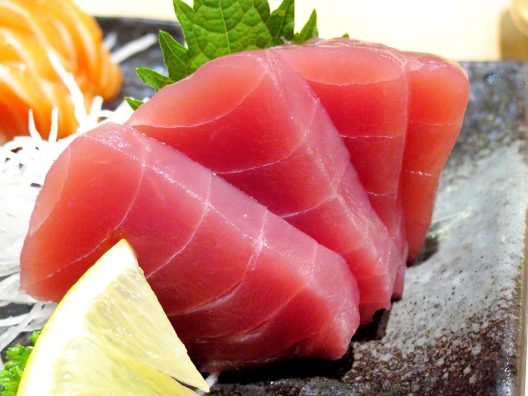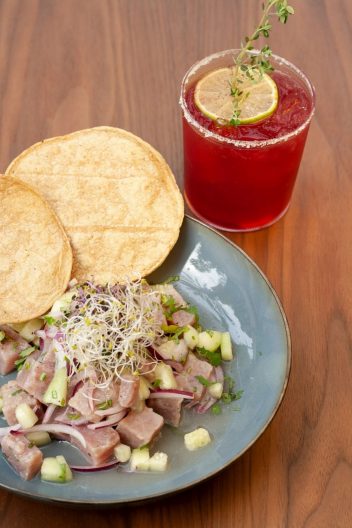Bolting Across Oceans and Enriching Culinary Traditions
In 2021, the reclassification of yellowfin tuna (Thunnus albacares) from Near Threatened to Least Concern on the International Union for Conservation of Nature Red List marked a monumental achievement in the realm of tuna conservation. This shift was a testament to the collective efforts invested to conserve this iconic species, ranging from including catch regulations, using ecosystem-based management approaches, and creating market-based incentives. As a result of utilizing multiple comprehensive strategies, we can continue to appreciate yellowfin tuna in oceans and culinary dishes worldwide.
Swiftly swimming in short bursts up to 48 kilometers per hour, the yellowfin tuna is a species renowned for their remarkable speed and agility in tropical and subtropical oceans worldwide, thriving in water temperatures from 18 to 31℃. Their torpedo-shaped body, optimized for hydrodynamic efficiency, enables them to slice through the water with unparalleled speed. Unlike many other fish species, yellowfin tuna are constantly in motion, a necessity driven by their reliance on passing water over their gills to extract oxygen, a process they cannot accomplish while stationary. Additionally, their countercurrent blood exchange mechanism allows them to maintain a higher body temperature than their surrounding water, enabling them to thrive in a wide range of oceanic conditions. While this adaptation aids their ability to swiftly navigate colder waters, it also demands a higher metabolic rate, requiring yellowfin tuna to consume approximately 5% of their body weight in food every day to sustain their energetic lifestyle. This increased metabolic rate allows them to efficiently extract energy from their diet, which primarily consists of a diverse array of fish, squid, and crustaceans, including krill and pelagic red crab.

With their distinctive yellow fins and tail, which give them their name, complemented by a metallic blue-black coloration on their back, yellowfin tuna hold an electrifying appearance that reflects their vibrant marine habitat. Growing up to 2 meters in length and weighing as much as 200 kilograms over their 6 to 7 year lifespan, yellowfin tuna are formidable hunters. Their swift speed allows them to pursue prey over long distances, exhibiting both endurance and agility. They are known to hunt opportunistically near the surface as well as at deeper depths, adapting their hunting strategies to exploit various ecological niches.
Highly migratory by nature, yellowfin tuna undertake epic journeys alongside other similarly-sized tuna such as bigeye tuna (Thunnus obesus), spanning thousands of miles, driven by changes in food availability and water temperatures. Their ability to sustain high speeds for extended periods enables them to traverse entire ocean basins, making them key players in the dynamics of marine ecosystems. As apex predators, they play a crucial role in regulating the populations of prey species, thereby helping to maintain the delicate balance of oceanic food webs.
Beyond their ecological significance, yellowfin tuna are also highly valued in the commercial fishing industry. According to NOAA Fisheries commercial fishing landings database, Pacific yellowfin tuna alone brought in $29.4 million in 2022, underscoring their economic importance. These fish are one of the most commercially valuable species due to their firm flesh and rich mild flavor, which has resulted in an increase in their use in cuisines around the world, serving as a bridge connecting people and cultures.
As concerns over the sustainability of yellowfin tuna rise due to increasing market demand, organizations like the International Commission for the Conservation of Atlantic Tunas (ICCAT), an intergovernmental fisheries organization responsible for the conservation and management of tunas in the Atlantic Ocean and adjacent seas, and the Western and Central Pacific Fisheries Commission (WCPFC), who manages tuna species in the western and central Pacific Ocean are working to set annual catch limits, maximum size limits, gear restrictions, and time and area closures. While conservation efforts have been successful, there is an ongoing need for monitoring and surveillance to ensure fishers are abiding by these regulations and if not, are reported to limit illegal, unreported, and unregulated (IUU) fishing activities. Furthermore, ongoing research to understand yellowfin tuna biology, migratory patterns, and impacts from fishing activities is vital to ensure we have the best available science to inform policies and regulations. Lastly, increasing the regional and international cooperation among regions and countries is crucial for data sharing and coordinating enforcement and conservation efforts to protect these highly migratory species. There will be ongoing challenges regarding the sustainability of these species amidst their wide range and a rising demand for this valuable species.
Despite these challenges, the allure of yellowfin tuna persists, especially in culinary traditions worldwide. Personally, my favorite way to have yellowfin tuna, also known as ahi in Hawaii, has been through indulging in poke. Ahi means fire in Hawaiian and has been used to describe this fish because they would smoke against the canoes of Hawaiian fishers when reeling these huge fish very fast. Poke, meaning to slice or cut, features cubes of marinated fish over rice. Originally, Hawaiians would massage ahi with salt to preserve the fish and add other locally caught ingredients such as seaweed and crushed kukui nuts for flavor. However, the introduction of soy sauce and sesame oil by immigrants from East Asia has led to a proliferation of poke varieties such as shoyu poke and spicy poke. Poke has increased in popularity due to its ease for customization by multiple cultures. In Hawaii, poke is often eaten as an appetizer or as bowls with marinated ahi on top of a bowl of rice. Poke bowls have increased in popularity and can be seen across the country. In essence, the widespread popularity of poke bowls has led to a diverse array of interpretations, with mainland poke shops adding multiple toppings ranging from avocado, carrots, corn, edamame, kimchi, and more, showing the evolving nature of this beloved dish.

In Japan, yellowfin tuna, also known as kihada maguro in Japanese, is often served as sashimi, which is thinly sliced raw fish, or as nigiri, which is the thinly sliced raw fish on top of a small bed of sushi rice. A fun aspect of seeing maguro served in Japan is that different parts of the fish are referred to and appreciated differently. Akami is the leanest red meat and makes up most of the fish, making it readily available. O-toro is the fattiest part of the tuna and is cut from inside the fish’s belly, making it the most fatty. As such, it practically melts in your mouth and is highly sought after, making it the most expensive cut. Chu-toro is medium fatty tuna and is a blend of akami and o-toro.

In Peru, yellowfin tuna, also referred to as atún, takes on a different culinary role and is often featured in vibrant ceviche dishes. Tuna ceviche brings out fresh flavors of the fish, accentuated by the tangy citrus marinade typically composed of lemon or lime juice. As the fish sits in the acidic juices, it is cooked as the proteins become denatured. This type of preparation leaves the fish with a firm yet tender texture while imparting a refreshing acidic flavor. In addition to the atún, ceviche often includes onions, cilantro, and chili pepper, adding both flavor and texture to the dish.

In embracing the culinary diversity that celebrates yellowfin tuna, from Hawaiian poke to Japanese sashimi and Peruvian ceviche, we not only savor the tuna’s exquisite rich flavor, but also deepen our connection to the oceans and conservation efforts they require around the world. I hope you get to indulge in the delightful experience of enjoying poke, sashimi, and ceviche, each offering its own unique exploration of yellowfin tuna’s versatility and taste. As we navigate the complexity of managing yellowfin tuna fisheries, let us foster a culture of shared responsibility for the stewardship of marine resources. By weaving together conservation initiatives, education, and cultural appreciation, we can secure a sustainable future for yellowfin tuna, enriching ecosystems and culinary traditions worldwide.